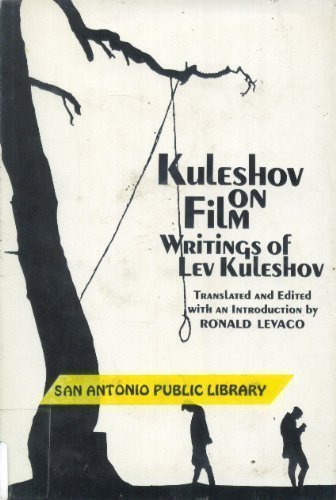Kuleshov on Film: Writings by Lev Kuleshov book download
Par smith lillie le lundi, juillet 4 2016, 13:23 - Lien permanent
Kuleshov on Film: Writings by Lev Kuleshov. Lev Vladimirovich Kuleshov, Ronald Levaco

Kuleshov.on.Film.Writings.by.Lev.Kuleshov.pdf
ISBN: 0520026594,9780520026599 | 121 pages | 4 Mb

Kuleshov on Film: Writings by Lev Kuleshov Lev Vladimirovich Kuleshov, Ronald Levaco
Publisher: Univ of California Pr
He said editing should make people think, not just see what they see. Il Cinema Ritrovato is an Archive Film Festival held annually in the Italian City of Bologna. He screened a short film of still images for an audience. Lev Kuleshov was a Russian filmmaker and media theorist in the 1920's who looked at how the audience read film. The Kuleshov effect is a film editing effect demonstrated by the Russian filmmaker Lev Kuleshov in the 1910's and 1920's. Montage is a synonym for a form of editing which was practiced by Soviet filmmakers Lev Kuleshov, Vesvolod Pudovkin, Dziga Vertov and Sergei Eisenstein around the 1920s at the Kuleshov school of film-making. This technique, described by critic Paul Arthur as “metaphoric The diametrical separation between films critically assembled from newsreels and the formalist “played film” frequently appears in the writings of Soviet editors. Lev Kuleshov (Cyrillic spelling Kulešov). This film intertwined three separate stories, taken from the life and writings of the O Henry (the pseudonym of W. Doublier, described as “the spiritual ancestor” of Lev Kuleshov, the Soviet montage theorist, uses the metaphoric properties of film to analogize the event where images do not exist. Posted by keith1942 on September 10, 2009. Lev kuleshov was among the very first to theorise about the relatively young medium of the cinema in the 1920s. For a week at the beginning of July about 900 enthusiasts watch films all day . He experimented with a single shot, of a mans face and put it alongside emotion provoking shots. Lev Kuleshov was an early Soviet director, possibly one of the first film theorists of montage, who worked prior to Eisenstein's appearance in film. Although Lev Kuleshov was the first to experiment with Montage, Eisenstein argued that the collision between two adjoining images creates a third meaning. Soviet film makers of the 1920s like Kuleshov, Pudovkin, and Sergei Eisenstein all were founding fathers of montage, although it is argued that Eisenstein defined. Lev Kuleshov was an early 20th century Soviet filmaker, the first aesthetic theorist of film, the man behind the montage.